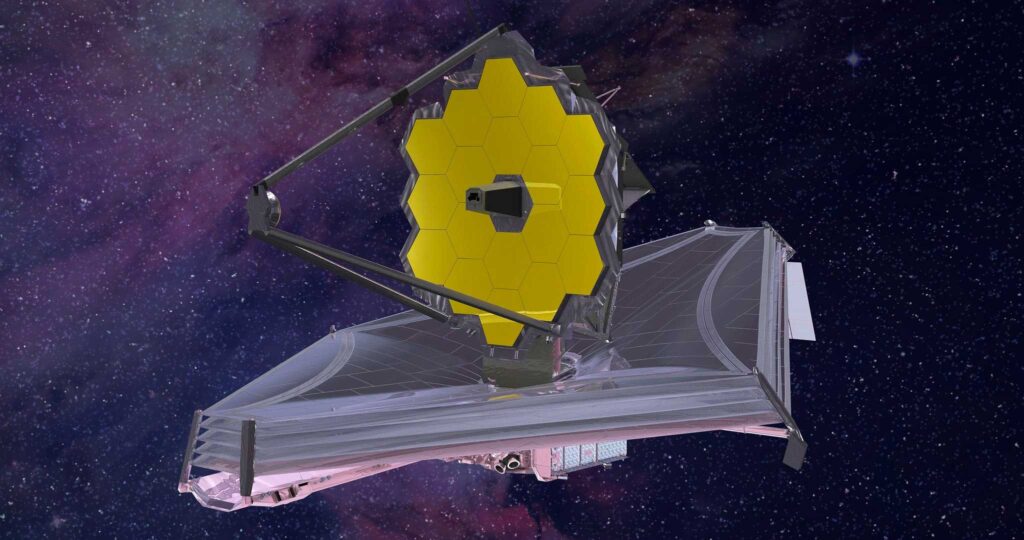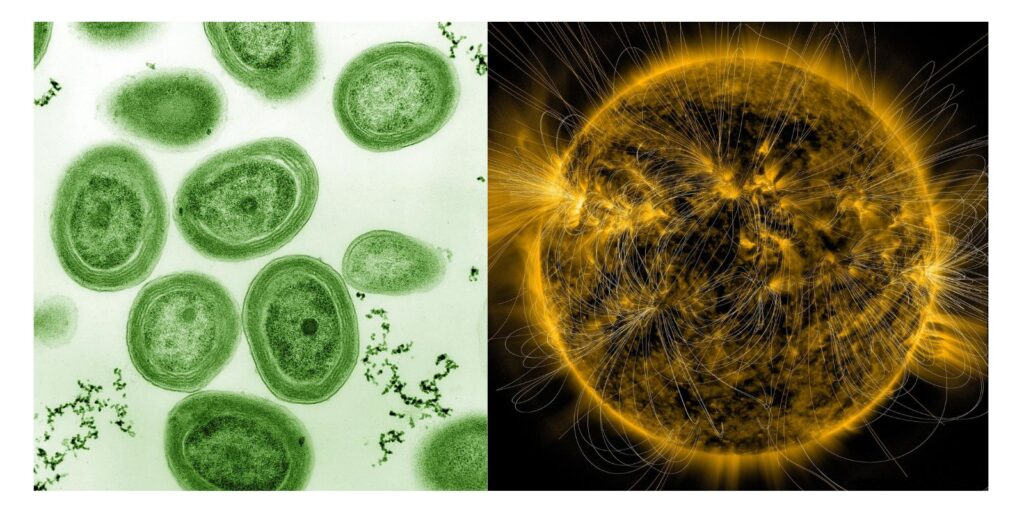
An illustration of the James Webb Space Telescope, the largest, most complex observatory sent into space. Credit: Northrop Grumman.
By Mariana Meneses
In past editions, The Quantum Record has explored the search for life within our own solar system—particularly on ocean worlds like Europa, Enceladus, and Triton, where vast seas of water lie hidden beneath layers of ice. We followed the Cassini probe’s revelations about water geysers erupting on Enceladus, examined future probes like NASA’s Europa Clipper and ESA’s JUICE, and looked ahead to the proposed Enceladus Orbilander.
Now, we follow the thread further out into the galaxy with a focus on K2-18b, an exoplanet whose atmospheric chemistry has sparked new questions about how, and where, microbial life might emerge beyond Earth.
The search for life beyond Earth continues with new data alongside long-established initiatives like SETI, the Search for Extraterrestrial Intelligence that’s looking for radio signals and interstellar artifacts, and more recent ones like Harvard University’s Galileo Project. Public interest continues to mount, stoked by recent findings like those disclosed in NASA’s 2023 report on Unidentified Anomalous Phenomena.
Oxygen was not a prerequisite for life on Earth, so could the same conditions evolve on exoplanets? Earth’s early atmosphere lacked oxygen and was rich in gases like carbon dioxide and methane. Early microbial life began in these conditions with little or no oxygen, and around 2.7 billion years ago cyanobacteria emerged that were capable of photosynthesis using the Sun’s energy and releasing oxygen as a byproduct. This oxygen began accumulating in the atmosphere, triggering the Great Oxidation Event after about 300 million years. Oxygen levels gradually rose over time, eventually enabling complex life.

In January, The Quantum Record reported on the way that cyanobacteria, pictured on the left, respond to seasonal changes on Earth resulting from our planet’s relationship with the Sun.
Recently, researchers from the University of Cambridge analyzing the atmosphere of exoplanet K2-18b identified molecular signatures that, on Earth, are known to originate exclusively from microbial life. Using data from the James Webb Space Telescope (JWST), they observed potential traces of dimethyl sulphide (DMS) or dimethyl disulphide (DMDS)—gases typically produced by marine phytoplankton and certain bacteria.
This marks the second and most compelling detection of possible biosignatures in K2-18b’s atmosphere, though both the research team and external experts emphasize that further observations are essential to confirm the finding.
The lead researcher, Professor Madhusudhan, told the BBC,”The amount we estimate of this gas in the atmosphere is thousands of times higher than what we have on Earth, so if the association with life is real, then this planet will be teeming with life. This is the strongest evidence yet there is possibly life out there. I can realistically say that we can confirm this signal within one to two years. If we confirm that there is life on K2-18b, it should basically confirm that life is very common in the galaxy.”
Strongest hints yet of biological activity outside the solar system
There is still considerable uncertainty surrounding the findings, as acknowledged by Dr. Madhusudhan’s team.
The current data does not meet the statistical threshold required to claim a confirmed discovery. The confirmation threshold is known as a five sigma result, which corresponds to a confidence level of 99.99999%. At present, the evidence stands at three sigma (99.7%) which, while promising, falls short of the standard required for scientific consensus. Even if future observations reach five sigma, that alone would not definitively prove the presence of life.
As noted by Professor Catherine Heymans, an independent astrophysicist from the University of Edinburgh, the presence of these molecules might still have non-biological explanations. On Earth, they are produced by microorganisms, but unknown geological or chemical processes on exoplanets could potentially yield similar compounds. The Cambridge team is now collaborating with other researchers to investigate whether such molecules can arise through abiotic mechanisms under planetary conditions.
A key part of the ongoing scientific debate around K2-18b concerns the planet’s structure, which remains uncertain. Since almost everything we know about exoplanets comes from the minuscule traces of light that interact with their atmospheres, researchers must extract vast amounts of information—including potential biosignatures—from an incredibly faint signal. Thanks to its exceptional sensitivity, the James Webb Space Telescope can detect and analyze the chemical composition of K2-18b’s atmosphere by observing how light from its small red star filters through it, offering unprecedented insight into distant worlds.

Illustration of what exoplanet K2-18b could look like based on scientific data. K2-18b is two-and-a-half times the size of Earth and is 700 trillion miles, or 124 light years, away from us. Credit: NASA, ESA, CSA, Joseph Olmsted and Nikku Madhusudhan.
Since the announcement, however, the initial excitement has met with growing scepticism.
Three independent research teams reanalyzed the JWST data and found no statistically significant evidence for DMS or DMDS in K2-18b’s atmosphere. While hydrogen, carbon dioxide, and methane were confirmed, the signal previously attributed to potential biosignatures appears too weak and ambiguous.
One group, led by Luis Welbanks, expanded the pool of possible molecules to 90 and found that over 50 could plausibly account for the signal. “When you detect everything, did you really detect anything?” Welbanks asked in a Phys.org article. The strongest candidate in their model wasn’t DMS, but propyne, which is a non-biological compound.
The Cambridge team led by Dr. Madhusudhan responded by running an even broader analysis, testing 650 possible molecules. DMS remained among the top candidates, though DMDS—the molecule that helped spark the initial enthusiasm—was no longer prominent. Other top-ranked molecules for life signature, such as diethyl sulfide and methyl acrylonitrile, were deemed unrealistic for K2-18b’s likely environment. Critics, including some of Dr. Madhusudhan’s former students, pointed out that the shift in conclusions came without any new data or methods, raising concerns about interpretive flexibility.
While Dr. Madhusudhan continues to stand by his findings and emphasizes the value of open scientific debate, others warn against premature claims. “We are the closest we have ever been” to detecting alien life, Welbanks noted, “but we must proceed with rigor, not speculation.” Upcoming JWST observations over the next year are expected to provide a more definitive picture—clarifying whether K2-18b is truly a world teeming with life or simply another case of cosmic mimicry.
As the debate around K2-18b unfolds, it highlights both the promise and the challenge of searching for life across interstellar distances. In a field where evidence arrives as faint distortions in starlight and where biology must be inferred from chemistry, progress depends not only on better instruments but also on scientific restraint.
Whether future data confirms a genuine bio-signature or rules it out entirely, the case of K2-18b reminds us that the search for life is also a test of how we interpret uncertainty—how we distinguish signal from noise, and possibility from proof.
Craving more information? Check out these recommended TQR articles:
- Thinking in the Age of Machines: Global IQ Decline and the Rise of AI-Assisted Thinking
- Everything Has a Beginning and End, Right? Physicist Says No, With Profound Consequences for Measuring Quantum Interactions
- Cleaning the Mirror: Increasing Concerns Over Data Quality, Distortion, and Decision-Making
- Not a Straight Line: What Ancient DNA Is Teaching Us About Migration, Contact, and Being Human
- Digital Sovereignty: Cutting Dependence on Dominant Tech Companies




